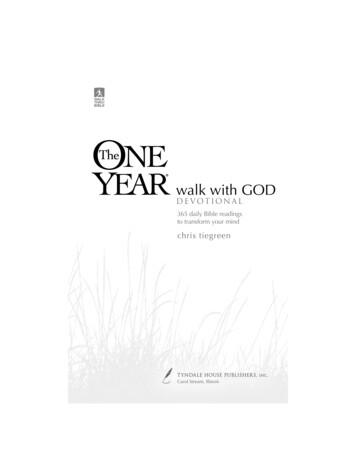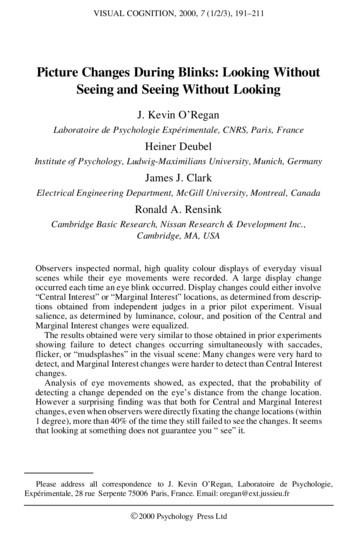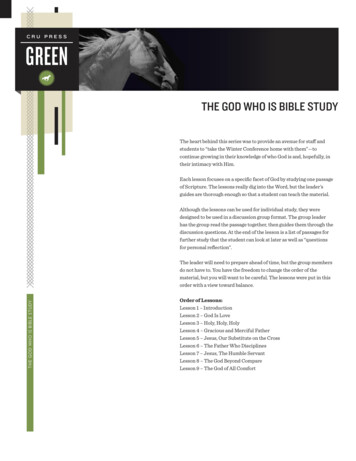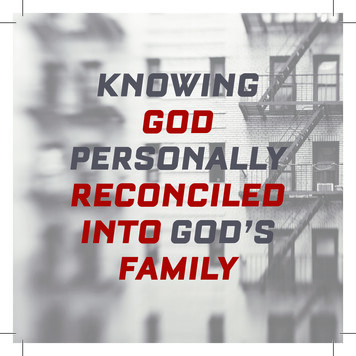
Transcription
4IN THE OLD TESTAMENTA 10-W eek B ible S tudyTheWisdomof GodSeeing Jesus in the Psalms& Wisdom BooksL E A D E R ’ SG U I D Enancy guthrie
The Wisdomof GodSeeing Jesus in the Psalms and Wisdom BooksLeader’s Guide(for use with both the book only orthe book combined with video study)nancy guthrieW H E AT O N , I L L I N O I S
The Wisdom of God: Seeing Jesus in the Psalms and Wisdom Books Leader’s GuideCopyright 2012 by Nancy GuthriePublished by Crossway1300 Crescent StreetWheaton, Illinois 60187All rights reserved. No part of this publication may be reproduced, stored in a retrieval system, or transmitted in any form by anymeans, electronic, mechanical, photocopy, recording, or otherwise, without the prior permission of the publisher, except as providedfor by USA copyright law.Based on the book The Wisdom of God: Seeing Jesus in the Psalms and Wisdom Books (A 10-Week Bible Study), first printing 2012Scripture quotations are from the ESV Bible (The Holy Bible, English Standard Version ), copyright 2001 by Crossway. Used by permission. All rights reserved.All emphases in Scripture quotations have been added by the author.ISBN 978-1-4335-3557-4
ContentsAn Introduction to The Wisdomof God for Leaders4Determining Your Schedule for StudyingThe Wisdom of God4Making the Most of the Personal Bible Study678Incorporating the “Looking Forward” SectionUsing the Discussion GuideIdeas and Resources forDiscussion Group FacilitatorsLeading Your Discussion Group WellUsing Your Time EffectivelyDealing with Common ChallengesWeek 1: The Wisdom Hiddenin the Wisdom BooksDiscussion GuideWeek 2: Job101011121515Personal Bible Study1717Discussion Guide20Week 3: Psalms: The Songs of JesusPersonal Bible Study2222Discussion Guide27Week 4: Blessing andPerishing in the Psalms29Personal Bible Study29Discussion Guide32Week 5: The Royal PsalmsPersonal Bible Study3434Discussion Guide37Week 6: Repentance in the PsalmsPersonal Bible Study3939Discussion Guide40Week 7: The Suffering and Gloryof Messiah in the Psalms42Personal Bible Study42Discussion Guide44Week 8: ProverbsPersonal Bible Study4646Discussion Guide49Week 9: EcclesiastesPersonal Bible Study5151Discussion Guide53Week 10: Song of SolomonPersonal Bible Study5454Discussion Guide58Note-taking Pages for Duplication60
An Introduction toThe Wisdom of God for LeadersThe Wisdom of God: Seeing Jesus in the Psalms andWisdom Books is an in-depth study of the OldTestament Wisdom Literature of the Bible, withthe goal of understanding it in the way that Jesushimself taught the disciples to read and understand the Old Testament: with him at the center.As we see not only the wise principles for livingin these biblical books, but also the wise personthey point to, it will help us to understand theperson and work of Christ more clearly whichwill prepare us to worship him more fully. Thisguide will equip you to plan and lead a study ofThe Wisdom of God using either the book alone,or the book along with the video series. Teachingexperience or gifting is not required to lead thisstudy—just a willingness to organize, oversee,and facilitate a meaningful discussion time, aswell as personal enthusiasm for knowing Christmore deeply through the study of his Word.Determining Your Schedule forStudying The Wisdom of GodThis study has been put together in a way thatoffers flexibility in how you use it and flexibility in how you schedule your time for workingthrough it. Everything is provided in the bookthat is needed by participants. Each week’s lesson includes: Personal Bible Study Teaching Chapter (with a “Looking Forward”addendum at the end of each chapter) Discussion GuideIt is divided into ten weeks of study. Butyou may want to carefully consider dividing thematerial in a way that would extend the studyover twenty weeks, giving your participantsmore time to think through and talk throughthe truths presented. Expanding the study mayalso be beneficial when you have only one houror less to meet together each week and alsowant to incorporate time for worship, prayer,or personal sharing into your small group time.Following are outlines for how the study wouldwork for different schedules.A 10-Week Book Study—Participants wouldneed to have books in advance of the first weekyou meet, with instructions to read the chapter in Week 1, “What We Need Most to Know,”before they arrive the first week. There is noPersonal Bible Study portion of the lesson forWeek 1. When you get together that first week,you can spend some time getting to know eachother, communicating the format you will use,and discussing the chapter you’ve all read, usingthe Discussion Guide for Week 1. From then on,participants will be asked to come to the grouptime having completed the Personal Bible Studysection and having read the Teaching Chapter ofthat week’s lesson (unless your group’s style willbe to read the chapter aloud as a group, whichsome groups elect to do). You may want to suggest to participants that they put a star besidequestions in the Personal Bible Study that theywant to be sure to bring up in the discussion,and underline key passages in the chapter thatare meaningful or that raise questions for themthat they’d like to discuss. During your timetogether each week you will discuss the big ideasof the lesson using the Discussion Guide, bringing in content from the Personal Bible Study andTeaching Chapter as you see fit.
5Sample Weekly Schedule for a 1-hour Study:7:00 Welcome, get settled, announcements, maybe singing7:10 Open discussion using the “GettingStarted” question found in theDiscussion Guide, working yourway through the Discussion Guidequestions, bringing in commentsand questions from the PersonalBible Study and Teaching Chapter asdesired.7:50 Take prayer requests and pray7:59 CloseA 11- or 12-Week Book Study—You mayprefer to meet the first week and distribute thebooks at that point, using that first week solelyto get to know each other and get organized.Assign the group to read the chapter in Week 1for discussion the following week and then proceed as outlined in the ten-week book study. Ifyou want to extend the study to twelve weeks,you might set a week following the last lessonto come back together, asking each member toplan to share the truths and take-aways fromthe study that have been most meaningful, orperhaps to talk through any lingering questionsfrom the study.A 20-Week Book Study—There is a greatdeal of material here and you may want to takeyour time with it, giving more time to discussits foundational truths, and allowing it to sinkin. To expand the study over twenty weeks,you would break each week into two parts.You would spend one week on the PersonalBible Study section—either doing it on yourown and discussing your answers when youmeet, or actually working through the questions together when you meet (which wouldlessen the amount of time required outside ofthe group time and perhaps diminish barriersto participation for those who struggle withworking through the questions on their own).Then, you would ask group members to readthe Teaching Chapter on their own before thenext meeting, and use the Discussion Guide todiscuss the big ideas of the lesson the followingweek. If you meet once for Week 1 (since thereis no Personal Bible Study section for the firstweek), and meet for a final week to share bigpicture truths taken away from the study, it willadd up to twenty weeks.Sample Weekly Schedule for a 1-hour StudyWeek A (Personal Bible Study):7:00 Welcome, get settled, announcements, maybe singing7:10 Work your way through the questions in the Personal Bible Study,looking up the answers together andallowing various members to sharewhat they are putting down.7:50 Take prayer requests and pray7:59 CloseWeek B (Teaching Chapter):7:00 Welcome, get settled, announcements, maybe singing7:10 Open discussion using the “GettingStarted” question found in theDiscussion Guide, working yourway through the Discussion Guidequestions, bringing in commentsand quotes from Teaching Chapterand reading the “Looking Forward”section together.7:50 Take prayer requests and pray7:59 CloseA 10-week Book Study Using the Video—If you’re using the book in combination withthe video series, group members will be askedto complete the Personal Bible Study section ofeach week’s lesson in the book before they come.On the videos, Nancy presents virtually thesame content as the Teaching Chapters minusthe “Looking Forward” addendum found at theend of each chapter. So if you are using the videoseries, participants have the option to:1. Read the chapter in advance as a preview ofwhat will be presented on the video.2. Just listen to Nancy teach the content ofthe chapter on the video and read only the“Looking Forward” as part of the group discussion time or on their own.
63. Go back and read the chapter after watchingthe video, if needed or desired, to seal in orclarify what was presented in the video.When group members miss a particularweek, you may want to encourage them to goto the website, www.seeingJesusintheOldTestament.com, where they can download the videothey missed, or they can simply read the chapterin the book.It is a good idea to encourage participantsto take notes during the video even though thecontent of the video is in the book. For eachvideo presentation, reproducible note-takingpages that you may copy for your group members are included at the end of this Leader’sGuide. Note-taking during the video is a goodidea because something transpires when weprocess words and ideas through a pen or pencil onto paper, which aids us in processing andretaining the words and ideas. But those takingnotes may also rest easy if they miss somethingsignificant, because the complete content isalso in the book.Sample Schedule for 2-hour StudyIncorporating the Video9:00 Welcome, get settled, announcements, maybe singing9:10 Watch video teaching session9:50 Respond to video with variouswomen praying as they feel led inresponse to what they’ve heard (notgeneral prayers, but responding towhat was presented). Because thelessons end each week in somepoignant ways, it will be helpful tobe able to be quiet and also respondto what was presented before rushing off to hallway conversation andsmall group discussion.10:00 Break to go to small groups10:05 Welcome, connecting and checkingin with each other time10:10 Start discussion using theDiscussion Guide and bringingin Personal Bible Study questionsgroup members want to discuss aswell as points made in the video.10:50 Take prayer requests and pray (besure that the prayer time is not onlyabout personal needs but also praying through the truths presented inthe passage you’re studying. Thiswill likely need to be modeled by theleader and/or assigned to one of thepeople praying).10:59 CloseMaking the Most of thePersonal Bible StudyThe question is often asked, “How long should ittake to complete the Personal Bible Study questions?” The answer is, there is no set time frame.We all approach this differently. Some participants love to luxuriate, think through, look up,and write out. Others have the approach of simply looking for the answers and making shortnotations rather than writing long answers toquestions. So how should you answer the question, “How much time should it take?” I suggestyou say that it takes as much time as they chooseto invest in it. Certainly some weeks they mayhave more time than others, and we all knowthat we get more out of a study the more we putinto it. The depth of thinking through the lesson is not necessarily reflected in the length ofanswers written on the page or the time spentaccording to the clock. What is most importantis not how much time it takes, but planning atime to work through the Personal Bible Studyand keeping that appointment. In fact, in thefirst week, you might ask each group member toshare with the group when she intends to workon the Personal Bible Study in the coming week.This will help everyone to think about theirschedule and set a time. One person’s strategymay serve to be helpful to someone else whohas not been successful in the past in carvingout time for personal study. You might ask thosewho have done similar studies if they prefer todo it in one sitting or to break it up over severaldays. Also suggest they consider using Sunday, aday set aside for God, to study God’s Word.
7Included in the following pages of thisLeader’s Guide is a copy of each week’s PersonalBible Study that includes possible answers tothe questions. This is provided for you as theleader to assist you in dealing with difficultquestions, but it should not be provided togroup members. I also encourage you to avoidhaving this Leader’s Guide open as you work onthe Personal Bible Study yourself just as yourgroup members are doing. We all know that it isa challenge to resist looking for the answers to acrossword puzzle in the back of the book whilewe’re working on it. And likewise, as the leader,it may be a challenge for you to resist workingthrough the questions with this resource atyour fingertips. After completing the PersonalBible Study yourself, you may want to look overthe suggested answers in this Leader’s Guideand add notes to your own answers as desiredin preparation for the group discussion ratherthan having this guide in hand during yourgroup time, which cannot help but imply thatthese are the “right” answers. You will findwhat I hope will be some helpful suggestionsfor encouraging your group members in regardto completing the Personal Bible Study in the“Dealing with Common Challenges” section ofthis Leader’s Guide.Incorporating the “LookingForward” SectionI grew up in church and have spent most of mylife in the evangelical culture with lots of soundBible teaching for which I am so grateful. Butfor most of my life I have had a very limited,and less than fully biblical, understanding ofheaven and eternity. I thought of heaven primarily being a place away from here where ourspirits go after we die to be with God forever.Honestly, I think I never really thought throughwhat the difference would be in that existencewhen what we repeatedly read about in theNew Testament in terms of the resurrection ofthe body (1 Corinthians 15, 1 Thessalonians 4)comes about at the return of Christ.Additionally, I always thought of God’s purposes of redemption being really only aboutpeople. I did not have an understanding of God’sintentions to redeem all of creation, includingthis earth, making it the place where we will liveforever in our resurrected bodies with Christ.But this is clearly the future hope that all of theBible is directed toward. The purposes of Godare not merely about Christians going to heavenwhen we die, but about his intentions to restoreall things, about heaven coming down to earth,and living forever with God in its perfectionand beauty like Adam and Eve once did in theGarden—except even better.I assume there are a lot of people who havehad a similar experience and limited understanding, and that is why I have made the consummation a part of every chapter in this study.To truly understand what God is doing in thesmaller bits of Scripture we study, we have tohave a sense of the big picture of the purposesof God. We must see every aspect of Scripturein context of the Bible’s larger story of creation,fall, redemption, and consummation. To reorient how we’ve understood heaven and eternity, we’ve got to see it not just in a handful ofpassages that we think of as telling us aboutthe return of Christ and “end times,” but ratherthroughout the whole of Scripture and in factevery part of Scripture. When we see it fromall of the various angles as we work our waythrough Scripture, it completes the picture andsolidifies our grasp on what is revealed aboutwhat is yet to come. That is one reason I’veincluded it in the “Looking Forward” section ofeach chapter. But another reason I have done sois because this is the essence of our Christianhope. Growing in our grasp of future realities inChrist helps us to face present difficulties withconfidence in Christ.If this understanding of what is ahead for us
8as believers is new to you like it was to me onlya few years ago or if you feel you need a firmergrasp on it, here are some resources that youmight find helpful:The Restoration of All Things (A Gospel Coalition Booklet)by Sam Storms (Wheaton, IL: Crossway, 2011)Heaven by Randy Alcorn (Wheaton, IL: Tyndale House,2004)How should you incorporate the “LookingForward” section in your group time? The “best”way is going to be whatever works best for yourgroup. You may do it differently on differentweeks. It may be more of a time issue than anything else. And it may depend on if your group isreading the chapters in the book or watching thevideo presentation of the Teaching Chapter. Thevideo presentation is the content of the TeachingChapter minus the “Looking Forward.” So if youare using the video, you may be more inclinedto want to include reading and/or discussing the“Looking Forward” section in your discussiontime, perhaps working it in with the final question in the Discussion Guide each week which isalways about how the particular passage beingstudied fits in with the larger story of the Bible.Or, since every person attending the video studywill have a copy of the book, you might simplysuggest that participants read that section of thechapter on their own sometime after watchingthe video before they go on to the next lesson.In this way they can really think it through andtake it in, bringing together all that they learnedin that week’s lesson.Using the Discussion GuideOftentimes in Bible studies in which we’re givena series of questions to work through on ourown, our group discussions consist primarily ofsharing the answers we found to the questions.But this study is different. While each week youwill want to ask participants if they have any lingering questions from the Personal Bible Studysection, or aspects about it they would like totalk about, the Discussion Guide for The Wisdomof God is designed to facilitate a discussionabout the broader themes from the passagesbeing studied. In this way we will be seekingnot just more information but to develop deeperunderstanding.As the leader, you should make it your goalto draw out the members of your group, creating an environment that is safe for personalstruggle, difficult questions, discovery, andeven ambiguity. Because the discussion questions don’t always lend themselves to simpleanswers, but provide for more interaction withthe themes and challenges of the passages beingstudied, you may want to spend some timeworking your way through the questions in theDiscussion Guide prior to the group time toanticipate where the discussion will be headed.You will find each week’s Discussion Guide inthe pages that follow along with a few notesfrom me. Since these questions are designedto bring out various perspectives, there are not“suggested answers” as I provide in the PersonalBible Study. However, where appropriate, I’vemade notes about issues that might come up inthe discussion or goals for particular questionswhere clarity might be helpful.You can use the Discussion Guide as a scriptto lead you through the discussion time. Or youcan use it simply as a resource, picking andchoosing the questions you think will be mosteffective with your group. You may also want toplan each week to invite participants to sharesomething that was significant or meaningful tothem from the Personal Bible Study, determining ahead of time at what point in the discussion you will invite those comments. On someweeks, you will find that a question is alreadyincluded in the Discussion Guide, connectingback to the Personal Bible Study that week.Each week the discussion begins with aquestion called “Getting the Discussion Going”
9which is designed to make people comfortablewith talking and sharing personally from theirlives. If someone does not have enough confidence in their understanding of the Bible to wantto talk much on the more biblical questions, thisis a question you may want to use to invite thatperson’s participation. If discussion comes toyour group quite easily, or if you’ve just watchedthe video presentation of the teaching and sensethe group is ready to dive directly into the heartof the lesson, you may want to skip this question. Admittedly, many of them are very lightweight, but are offered for the purpose of givingthose who may be hesitant to talk about the biblical material an opportunity to talk in the groupsetting. Feel free to skip it, if you’d like, andinstead head directly to the heart of the matter.Depending on the amount of time youhave, you may want to work through each of the“Getting to the Heart of It” questions, or you maywant to select only a few of these questions tosave time for the final two key questions.While the bulk of the discussion questionscenter around the biblical storyline and the theology presented in the passage at hand, eachweek there is also a “Getting Personal” question. This is where you will want to be especiallysensitive to encourage a number of people toanswer and not allow the discussion to simply follow the flow of the initial comments. Besure to go back to the original question at somepoint, asking other participants to share theirthoughts and experiences that may be differentfrom those shared first.The Discussion Guide presents a final question each week that will help participants togrow in their grasp of the larger story of theBible and how the passage at hand fits into thatlarger story. If your experience is like mine, thisis the part of Bible study that has been lackingfor most of my life. Often in studies we havejumped quickly to personal application to thelife of faith, and we haven’t stepped back todevelop our understanding of the implicationsof the particular passage we are studying inlight of the larger story of God’s redemption ofall things through Christ. But as we develop ourunderstanding of how God has worked and isworking to bring about his plans, we find that itactually helps us to understand and apply partsof Scripture that otherwise would be difficult tograsp. If you want to develop more of your ownunderstanding of the larger story of the Bible,you may want to supplement your study withone of the following books that I have foundhelpful:According to Plan: The Unfolding Revelation of God in theBible by Graeme Goldsworthy (Downers Grove, IL:InterVarsity, 1991)Biblical Theology in the Life of the Church: A Guide forMinistry by Michael Lawrence (Wheaton, IL:Crossway, 2010)Far as the Curse Is Found: The Covenant Story ofRedemption by Michael Williams (Philipsburg, NJ:P&R, 2005)God’s Big Picture: Tracing the Storyline of the Bible byVaughan Roberts (Downers Grove, IL: InterVarsity,2002)The God Who Is There: Finding Your Place in God’s Storyby D. A. Carson (Grand Rapids, MI: Baker, 2010)The Mission of God: Unlocking the Bible’s Grand Narrativeby Christopher J. H. Wright (Downers Grove, IL:InterVarsity, 2006)
Ideas and Resources forDiscussion Group FacilitatorsThank you for your willingness to lead a groupthrough this study of the Wisdom Books in theOld Testament. I always find that when I lead, Ilearn far more than I do when I’m just a memberof the group because I know I must invest moreeffort to truly “own” the material. I hope that theextra investment in this study of the WisdomBooks will be a blessing to you as you seek toeffectively lead your group.Leading Your Discussion Group WellWhat is your goal or role as a discussion leader?I suggest you make it your goal to guide yourgroup through a time of open and authenticdiscussion of the biblical truths presented inthe Personal Bible Study and Teaching Chapteror video, seeking to clarify challenging concepts, solidify the group’s grasp of the truthspresented, and apply those truths to real life.Sometimes we have anxiety about leading or arereluctant to lead because we know we don’t haveall the answers, and we’re afraid someone willcome up with a question we can’t answer or willtake the discussion in a direction we can’t handle. Don’t allow yourself to be intimidated by thefalse expectation that if you step up to facilitatethe discussion you must have all of the “right”answers. Too many times in our discussionsof the Bible, someone in the group (and oftentimes it is the leader) feels he or she must sumup every part of the discussion with the “right”answer. But as you lead your group, I encourageyou to avoid the compulsion to come quicklyto the “right” answer to every question. Don’tbe afraid to let some questions hang for a whileor to allow members to struggle with the issuesinvolved in the series of questions. Keep askingfor the input of other participants. Also, there’snothing wrong with admitting, as the leader,that you don’t know something or don’t fullyunderstand something and need to do somemore study on it or want to invite someone onthe pastoral staff to help answer the question.Determine to lead your group as a fellow-learnerand not as an expert who knows all. Expect Godto use his Word not only in the lives of yourgroup members but in your life as well!Also be careful, as the leader, that you area facilitator and not a dominator. Our goal as afacilitator is to encourage other people to talkand discuss, and sometimes, because we are soenthusiastic, we, as leaders, can tend to dominate the discussion. For some of us, it requiressignificant effort to limit our own input in thediscussion so that others will be encouragedto talk.While you do not want to dominate thegroup, you do want to lead effectively and efficiently. I assure you that you will have groupmembers who will want you to lead withstrength to create an environment that fostersmeaningful discussion. As the leader, you setthe tone for authenticity and openness. You setan example of giving short answers so that others can talk, and of being a good, responsive listener. Being an effective leader also means thatit is up to you to bring reluctant talkers into theconversation and to redirect the conversationwhen it has gone off-track. Few people want tobe part of a group that is inflexible, restrictive,or rules-oriented, but they do want to be partof a group that is organized and purposeful, in
11which expectations are unapologetically communicated and stated guidelines are respected.manage this area with a blend of appropriatefirmness and grace.Using Your Time EffectivelyPrayer RequestsMany times, we want our small-group discussion times to include a time of sharing prayerrequests, which is a meaningful way of sharing our lives together and exercising our trustand relationship with God. But we also knowthat sometimes sharing requests can turn intotelling long stories and lengthy discussions asother members offer advice or input. One way tohandle this, if the use of time for prayer requestsis a concern for your group, is to provide notecards for people to write down their requestsand share them at the end or simply have members swap cards with someone else. Or you maysimply want to determine a time to bring yourdiscussion to a close that will allow for time atthe end for sharing requests, praying togetherover those requests, and praying through thetruths presented in the lesson.As the leader, you have the responsibility fordirecting how to use the time for group discussion. While some participants may be verycasual about how the time is used, others inyour group are very aware of the time andbecome frustrated when they feel their valuabletime is being wasted. There are several issues,I’ve found, that have a significant impact onusing the time allotted for small-group discussion effectively:Getting StartedSo often we run out of time because we are slowto get started. We are waiting for latecomers, orchatting, or enjoying some food together andsimply let valuable discussion time get awayfrom us. All groups develop a culture, and members learn whether the group will really starton time or not, and they adjust their sense ofurgency in regard to arrival time accordingly.Certainly you need to allow some time for participants to greet each other and to share theirlives with each other, but you will want to determine how long that will last and give the groupa firm start time for the discussion. If you set aculture of starting on time regardless of whetheror not everyone in the group has arrived, andnot allowing latecomers to interrupt your discussion when they arrive, you may likely findthat group members become more punctual.On the first day you meet, be sure to askmembers to join the group and enter into thealready-commenced discussion as unobtrusively as possible when they arrive after thediscussion on the lesson has started. When westop the discussion while everyone greets thelate arriver, perhaps hearing the story of whatcaused the lateness, it can be challenging toget started again. You as the leader will need toGetting Stuck Along the WaySo often we give too much time to earlier questions and simply don’t have time to work our waythrough all that we want to cover. I strongly suggest you look over the Discussion Guide beforeyour group time to determine how you will usethe time. Mark the key questions you must getto. Make a note beside each question you wantto be sure to include, indicating an estimate ofhow much time you want to give for discussingthat question, and then watch the clock alongthe way to keep on track.Keeping the Focus on God’s WordPeople come to a Bible study for many reasons,from many situations and struggles, and withvarying levels of knowledge of and interest inthe Bible. Sometimes our groups can easily slipfrom being a Bible study group into becoming more of a personal support group. Findingthat right balance between biblical study and
12personal support is a significant challenge forevery small-group leader.I’ve sometimes heard group leaders say thatwhen a group member a
The Wisdom of God: Seeing Jesus in the Psalms and Wisdom Books is an in-depth study of the Old Testament Wisdom Literature of the Bible, with the goal of understanding it in the way that Jesus










